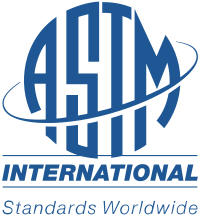Summary
The use of standards is considered a critical component in the assurance of analytical quality, allowing reliable measures of detection limits, accuracy, and reproducibility. These standards may be in the form of physical materials (test or reference materials), vetted data, validated algorithms, calibration services, and documentary standards.
Description

Montage of symbolic standard activities (from bottom clockwise): authoritative documentary standards, inkjet-printed fingerprint used as test material for sampling, and a precisely manufactured microsphere containing explosive used as a trace particle standard
A foundational activity that crosscuts our research goals is the development of a variety of standards and test materials to support the effective operation of trace explosive and narcotic detection devices. Trace sampling issues are addressed through fundamental studies on the adhesion and collection of particles, by both swiping and air-jet harvesting procedures. These studies are leading to the development of realistic standard particles, produced by inkjet technology, and standard methods for collection. Trace detection issues in commercially available instruments are being addressed for particles and vapors. Trace reference swipes, containing a designed blend of contraband compound, matrix binders, and background contaminants, are produced for intercomparison exercises and for other agency clients. Documentary standards are produced and evaluated for international standards agencies.
Standard Sampling Metrology

NIST has pioneered the use of controlled metrology measurements to evaluate and optimize the sampling and collection of trace residues, especially explosive materials. The success of explosive trace detection as a primary screening method was, in part, enabled by this research. NIST will expand on this effort to include trace narcotic residues and investigate collection efficiencies. Studies of swipes with modified, scored surfaces show improved collection efficiencies. Scores were produced with the razor cutting system to coincide with the limited circular area of the wipe interrogated by the thermal desorber of a typical explosive trace detector system. Optimization of trace narcotic residue collection will impact research into the use of trace detection methods to correlate the contents of packages with what is present on the package.
"Improving particle collection efficiency of sampling wipes used for trace chemical detection", Gillen, Greg, Lawrence, Jeffrey, Sisco, Edward, Staymates, Matthew E., Verkouteren, Jennifer, Robinson, Elizabeth L., Bulk, Alexander", Anal. Methods, 14, 581-587, (2022). http://dx.doi.org/10.1039/D1AY01609A
“A new wipe sampling instrument for measuring the collection efficiency of trace explosives residues,” E. L. Robinson, E. Sisco, M.E. Staymates and J.A. Lawrence, Anal. Methods 10, 204-213, (2018).
“Standardized Method for Measuring Collection Efficiency from Wipe-sampling of Trace Explosives,” J.R. Verkouteren, J.A. Lawrence, M.E. Staymates and E. Sisco, Journal of Visualized Experiments (122), 55484 (2017).
“New particle-based trace explosive test material produced by drop-on-demand inkjet printing for quantitative wipe-sampling studies,” J.R. Verkouteren, J.A. Lawrence, T.M. Brewer, and E. Sisco, Analytical Methods, 9, 3441-3449 (2017).
Precision Deposition of Materials for Trace Detection Standards

NIST utilizes inkjet printing and other novel fluid microdispensing technologies to develop test materials to support field evaluation of new and deployed systems for trace contraband detection. The suite of test materials under development include explosives, narcotics, adulterants, pharmaceutical compounds, and emerging threats. Methods for accurate quantitative analysis of deposited new and emerging threat compounds are being developed for validation of the test materials, including illicit narcotics.
"Sub-picoliter Traceability of Microdroplet Gravimetry and Microscopy", Lindsay C.C. Elliott, Adam L. Pintar, Craig R. Copeland, Thomas B. Renegar, Ronald G. Dixson, B. Robert Ilic, R. Michael Verkouteren and Samuel M. Stavis. Analytical Chemistry 94 (2021) 678-686. https://doi.org/10.1021/acs.analchem.1c02640.
“The production of monodisperse explosive particles with piezo-electric inkjet printing technology,” M. Staymates, R.A. Fletcher, J.R. Verkouteren, J. Staymates and G. Gillen, Review of Scientific Instruments 86, 125114 (2015).
“Performance Metrics Based on Signal Intensity for Ion Mobility Spectrometry-Based Trace Explosives Detectors using Inkjet Printed Materials,” J.R. Verkouteren, J. Lawrence, G.A. Klouda, M. Najarro, J. Grandner, R.M. Verkouteren and S.J. York, Analyst, 139, 5488-5498 (2014).
Anticipatory Standards for Contraband Detection

In a world of rapidly changing and diverse threat materials there is a need to develop timely and relevant test materials and standards. NIST is currently developing standard test materials for illicit narcotics. Recently a pilot program has been started where portions of illicit materials seized by law enforcement and interdiction agencies will be characterized for composition and repurposed as test materials to be disseminated rapidly to front-line forensics labs to aid in detection and identification of emerging threats. This will coincide with the creation of a digital standard, i.e., a mass spectra library, to accompany the new test materials. For narcotics, realistic formulations of test materials that give the correct measurement response may depend on the physical and chemical form of the compound. To address this NIST will explore the role that crystallinity and morphology play in the collection/sampling and analysis of contraband materials.
"Unsupervised Pharmaceutical Polymorph Identification and Multicomponent Particle Mapping of ToF-SIMS Data by Non-Negative Matrix Factorization", Forbes, Thomas P., Gillen, John Greg, Souna, Amanda J., and Lawrence, Jeffrey, Analytical Chemistry, 94 (2022) 16443-16450. https://doi.org/10.1021/acs.analchem.2c03913.
ASTM Documentary Standards

We are involved in ASTM International, Committee E54 for Homeland Security Applications, by lending our expertise in sampling and detection of trace contraband for the development of standards. As ASTM members, we evaluate all documentary standards that originate from this committee and have helped develop, and championed, many test methods, practices, and specifications.
ASTM E2520-21, Standard Practice for Measuring and Scoring Performance of Trace Explosive Chemical Detectors, https://doi.org/10.1520/E2520-21.
ASTM E2677-20, Standard Test Method for Estimating Limits of Detection in Trace Detectors for Explosives and Drugs of Interest, https://doi.org/10.1520/E2677-20.
“ASTM E2677: International Standard on Limit of Detection for Trace Detectors: Explosives, Opioids, and Ozone,” R.M. Verkouteren, N.A. Heckert, S. Leigh, E. Sisco, J.E. Norris, J. Lawrence, and A. Burns, Detection Limits in Air Quality and Environmental Measurements, M.J. Brisson editor, ASTM STP 1618, pp. 31-48 (2019). https://doi.org/10.1520/STP161820180074.
“Web-Based Calculator for ASTM E2677 Limits of Detection,” N.A. Heckert, R.M. Verkouteren, K. Kwiatek, Detection Limits in Air Quality and Environmental Measurements, M.J. Brisson editor, ASTM STP 1618, pp. 49-59 (2019). https://doi.org/10.1520/STP161820180078.

